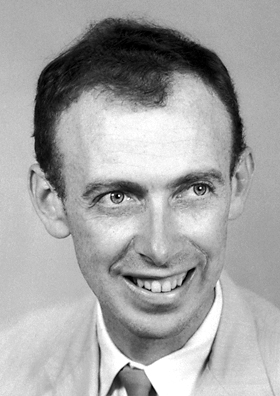Watson: Difference between revisions
Jump to navigation
Jump to search
No edit summary |
No edit summary |
||
| Line 1: | Line 1: | ||
[[Image:Watson postcard.jpg|left|James Dewey Watson]] James Dewey Watson was born in Chicago on April 6th 1928. Watson was most notably awarded the Nobel Prize in Physiology or Medicine 1962<ref>http://www.nobelprize.org/nobel_prizes/medicine/laureates/1962/watson-facts.html</ref> along side [[Francis Crick|Francis Harry Compton Crick]] and [[Maurice Wilkins|Maurice Hugh Frederick Wilkins]] | [[Image:Watson postcard.jpg|left|James Dewey Watson]] James Dewey Watson was born in Chicago on April 6th 1928. Watson was most notably awarded the Nobel Prize in Physiology or Medicine 1962<ref>http://www.nobelprize.org/nobel_prizes/medicine/laureates/1962/watson-facts.html</ref> along side [[Francis Crick|Francis Harry Compton Crick]] and [[Maurice Wilkins|Maurice Hugh Frederick Wilkins]]. Watson and Crick discovered the structure of DNA via x-ray diffraction, their model of a double helical configuration showed how a DNA molecule could duplicate itself.<ref>http://www.biography.com/people/james-d-watson-9525139#early-years</ref> | ||
<br> | |||
<br> | |||
<br> | |||
<br> | |||
<br> | |||
<br> | |||
<br> | |||
<br> | |||
<br> | |||
<br> | |||
<br> | |||
<br> | |||
<br> | |||
<br> | |||
<br> | |||
<br> | |||
=== References === | |||
<references /> | |||
<references /> | <references /> | ||
Revision as of 01:13, 28 November 2014

James Dewey Watson was born in Chicago on April 6th 1928. Watson was most notably awarded the Nobel Prize in Physiology or Medicine 1962[1] along side Francis Harry Compton Crick and Maurice Hugh Frederick Wilkins. Watson and Crick discovered the structure of DNA via x-ray diffraction, their model of a double helical configuration showed how a DNA molecule could duplicate itself.[2]
References